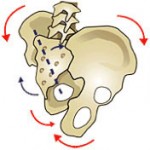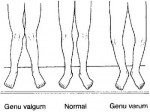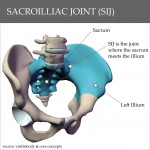
Edit:
This is an older article (almost a decade at the point of this edit) and is no longer in keeping with my belief system.
Pain is complex, and the following is not at all representative of that complexity.
Our sense of pain and dysfunction is highly influenced by biopsychosocial factors, and our own perceptions.
The reason I still keep this article up and others from a similar time are that I believe it’s important to be transparent about the fact that we in this industry are all fallible, and that there is no shame in admitting that you were previously speaking from a place of lesser knowledge.
Thank you, and I hope you enjoy a chuckle as you read 🙂
This is the joint between the sacrum (a large triangular bone at the bottom of the spine) and the ilium (the biggest part of the pelvis). The sacroiliac (SI) joint is important in all motions involved in weight transfer, and any motion where force is transferred through the pelvis. When the SI joint is weakened, excessively mobile or immobile we can experience pain. Most commonly regarding pain in the knee we will see a lack of mobility in the SI joint above the knee.
Why is this?
If the SI joint doesn’t move, the muscles that act on the pelvis from the thigh when we walk will have to work harder to transfer movement through the pelvis. Those muscles also act on the knee joint by pulling the tibia (shinbone) forwards and backwards. Take the quadriceps (thigh) muscle group for example: when the quadriceps straightens the knee, they use the patella as a fulcrum to help them. If the quadriceps has to exert too much force to straighten the knee, they will compress the patella and femur more than normal and will essentially grind them together. This is now a case of PFS even though the pain is caused by a pelvis that isn’t allowing for smooth weight transfer from the thigh to the knee.
The SI joint is a surprisingly complicated joint, it allows the pelvis to flare in or out, allows each half to partially rotate independently and to flex forwards and backwards (known as counternutation and nutation). These motions are key in allowing the entire complex of the leg to function properly.
 The SI joint can become immobilized in neutral position, or in a position of nutation or counternutation; this further exacerbates the discomfort in the knee by tilting the pelvis and effectively shortening anterior or posterior muscles attaching to the pelvis. Muscles being shortened anterior to posterior leads to the standard inappropriate force coupling experienced about the knee joint with shortened muscles; short quadriceps experience more tension across the patella and short hamstrings create a posterior translation of the tibia on the femur effectively compressing the meniscus and/or irritating the bursae in/around the patella.
The SI joint can become immobilized in neutral position, or in a position of nutation or counternutation; this further exacerbates the discomfort in the knee by tilting the pelvis and effectively shortening anterior or posterior muscles attaching to the pelvis. Muscles being shortened anterior to posterior leads to the standard inappropriate force coupling experienced about the knee joint with shortened muscles; short quadriceps experience more tension across the patella and short hamstrings create a posterior translation of the tibia on the femur effectively compressing the meniscus and/or irritating the bursae in/around the patella.
If one or both SI joints experience pathologies resulting in an inflare/outflare, the main effect on the knee will be experienced in the inward or outward femoral rotation and resultant tilt of the knee in compensation (this is known as genu valgus or genu varus) to balance out the effective tilting in or out of the hip joint. Besides simple discomfort, the valgation from an inflare can increase vulnerability of the medial collateral ligament as well as increasing iliotibial band friction. The varation from an outflare causes less immediate pain as the dysfunction focuses more around the medial meniscus but does cause more wear on the meniscus and can increase tendency to tear.
Besides simple discomfort, the valgation from an inflare can increase vulnerability of the medial collateral ligament as well as increasing iliotibial band friction. The varation from an outflare causes less immediate pain as the dysfunction focuses more around the medial meniscus but does cause more wear on the meniscus and can increase tendency to tear.
Other deviations of sacroiliac joint function affect the knee in much the same way, or a variation of these ways.
What Can Massage Therapy Do?
A skilled massage therapist can assess the angles of these joints during both movement and static stance to determine if there is contribution to any knee discomfort. Simply stretching and/or strengthening the proper muscles and increasing mobility through the joint may be enough to eliminate knee discomfort.
For injuries at the SI joint such as ligament strains leading to discomfort in the knee the therapist will be able to determine the original cause of the discomfort and by treating the injury recover will speed, and pain will greatly decrease.
For any questions on this article, please contact me at the email address listed on my website. I will answer whatever questions I can and we can set up a meeting to assess the causes of the knee pain if necessary.



